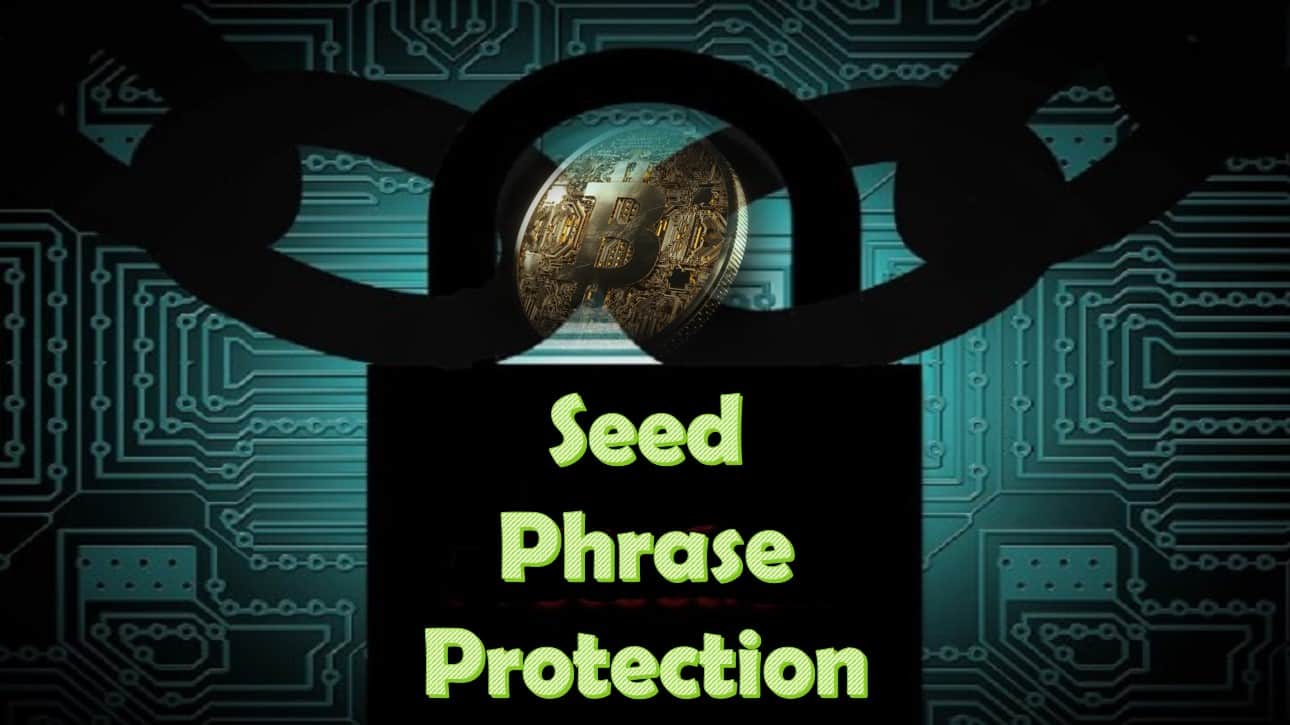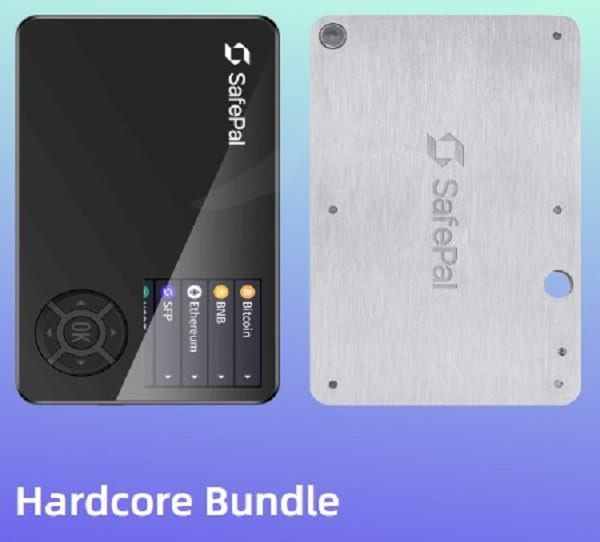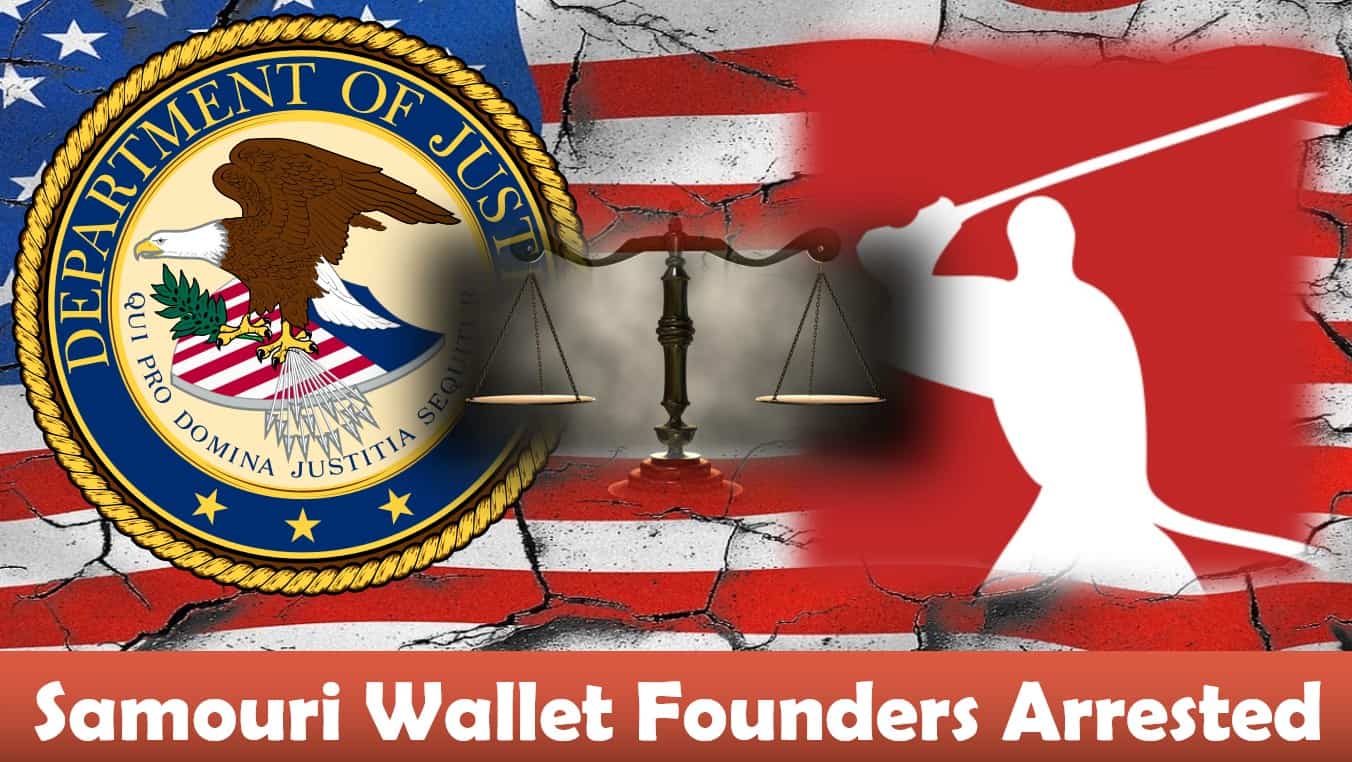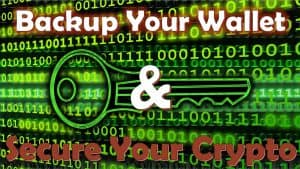
Bulletproof Your Crypto: Safeguarding Your Seed Phrase
Last updated on October 30th, 2025 at 12:14 pm
In the fast-paced world of cryptocurrencies, one rule is sacrosanct – protect your seed phrase like it’s a bar of gold.
Why?
Because in essence, it’s even more valuable.
In the wrong hands, your seed phrase is a skeleton key to your digital fortune, a master password that can grant a nefarious hacker the ability to empty out your wallet faster than you can say “Bitcoin.”
“Protecting Your Seed Phrase” refers to safeguarding the unique set of words that act as a key to a cryptocurrency wallet which is vital for maintaining control over your digital assets. Loss or sharing of a seed phrase can lead to irreversible asset loss. Best practices include storing it securely offline and never sharing it.
Imagine waking up one morning to find your investment, perhaps accumulated over years of careful trading and judicious HODLing, vanished into thin air.
It’s the equivalent of leaving your house keys under the doormat with a neon sign saying “Welcome, burglars!”
That’s the nightmare scenario that will unfold before you if your seed phrase falls into the wrong hands.
But fear not, there are stringent, yet simple ways to secure your seed phrase, turning your digital wallet into a fortress.
As someone deeply immersed in the crypto space since 2017, I understand the importance of safeguarding your seed phrase.
I’ve witnessed the devastating consequences of lost or compromised seed phrases, and I’m here to help you protect yours.
I’ve learned from experience that the responsibility of seed phrase protection lies solely with the individual
In this article, I will use my experience to help you delve deeper into the best practices for securing your seed phrase, ensuring that your cryptocurrency investment remains as safe as possible.
Now that you understand the importance of securing your seed phrase, lets take a look at some practical ways of doing just that.
Protecting Your Digital Kingdom
- Understanding Seed Phrases
- Best Practices for Protecting Seed Phrases
- Ongoing Vigilance
- Bulletproof Your Seed Phrase
- Frequently Asked Questions (FAQ)
Understanding Seed Phrases
Seed phrases, also known as mnemonic phrases or backup phrases, are important for all cryptocurrency wallets.
A seed phrase is a set of words generated by your wallet, typically consisting of 12-24 random words.
The seed phrase contains all the information about the wallet. This includes the wallets private keys, and addresses associated with it.
These words that make up your seed phrase have the power to recreate your wallet. This means your private keys and all the addresses associated with them.
Need a more in-depth understanding of seed phrases?
Read my comprehensive breakdown of seed phrases for cryptocurrency wallets right here.
At the end of the day, one of the most important things to understand about your seed phrase is that losing or compromising it can lead to permanent loss of funds. So prioritizing its security is of utmost importance.
There are some best practices you can follow to increase the security of your seed phrase and ultimately your crypto assets.
To ensure the safety of your seed phrase, let’s look through those important steps so you can start protecting your seed phrase today.
Best Practices for Protecting Seed Phrases
Whether you’re new to cryptocurrencies, or an experienced investor, understanding how to protect your seed phrase is crucial.
Imagine your seed phrase as the key to your cryptocurrency kingdom. It holds the power to unlock your digital wealth.
However, it’s essential to remember that even the strongest key can benefit from additional layers of protection
In this section, we’ll explore the concept of a layered security approach to fortifying the defenses around your seed phrase.
Most of these are simple, yet effective strategies, that build upon one another, creating multiple lines of defense to shield your seed phrase from loss, theft, and unauthorized access.
By implementing a layered approach, you’ll have peace of mind knowing that even if one layer is compromised, there are additional barriers in place to protect your valuable assets.
It’s like having locks, alarms, and security cameras guarding your digital fortune.
So, get ready to arm yourself with the knowledge, and practical tips needed to preserve the integrity of your seed phrase.
Seed Phrase Backup
Arguably the most important way to secure your seed phrase is to properly backup your crypto wallet.
By creating a backup of your seed phrase, you ensure that even if your device is lost, stolen, or damaged, you still have a way to regain access to your funds.
It’s like having a spare key hidden away, just in case.
However, the backup should be handled with the utmost care. Treat it like your most valuable possession, because that’s exactly what it is.
Keep it safe and secure, away from prying eyes or potential threats.
This point of not sharing your seed phrase is truly important. Because whomever you share it with has the ability to take control of your crypto assets
Think of it like giving someone the password to your bank account. Once you do, they can log in and get all of your money.
The difference however, with a bank, someone from customer service might be able to help you regain access to your funds.
The same is not true for your cryptocurrency wallet. There is no customer service to help you, and no way to recover your funds.
On a side note, for those of us with heirs, who would like to ensure that they are able to access our crypto in the event of our death, there are a number of ways to accomplish this.
One of these ways is to share your wallet information with a trusted family member.
While this is an option, it may not be the best option.
If you are looking to leave your crypto holdings to family, friends, charities or more, you should consider learning more about crypto inheritance planning.
You can find more information about crypto inheritance planning here.
Remember, by taking all the necessary precautions to protect your seed phrase, you can ensure that your investments remain safe, secure and completely under your control.
One tried and true method is to write it down on paper, and store it in a secure location, like a home safe.
To make this backup method even safer, it is a good idea to create multiple copies and secure them in different geographic locations.
You should never store your seed phrase on any online server or cloud-based storage system, as these services can be hacked or compromised
While the phrase “write it down” most often means on paper, there are other ways of writing it down.
As a matter of fact, these other methods and devices are preferable to paper as they don’t degrade over time, or get destroyed by fire or water.
Increased Backup Protection
Steel is currently the best way to backup your seed phrases.
There are several companies who have products of various designs. Many of them offer “bundle packages” that not only include a steel backup, but a hardware wallet as well.
Two of my recommendations are the Ledger Steel Capsule and the SafePal”s HardCore Bundle.
The Steel Capsule from Ledger is a solid steel tube created to withstand extreme conditions. Inside of this steel tube, you will store your 12 or 24 word seed phrase.
This process is easy, you’ll take the letters that spell out your seed phrase, slide them onto the tube, secure the letters in place, then seal it up and put it in a safe location.
But, if this isn’t exactly what you’re looking for, Ledger has two other steel options, which are more expensive, and are set up a bit differently. However, they are exceptional options for securing your seed phrase.
These two alternatives are The BillFODL and CryptoTag Zeus. These steel options are sold separately or as I mentioned earlier, in a bundle package with a hardware device.
BillFODL is a steel case that stores your seed phrase. By using tiles, and securing them inside the case, you can backup an entire 24 phrase.
The CryptoTag Zeus is a 6mm thick titanium sheet. You use a conversion sheet, and punch your seed phrase into the titanium. When you’re done, you enclose the titanium sheet in the case and burn the conversion sheet.
If Ledger is not your preferred hardware wallet option, especially since the whole Recover debacle, then perhaps SafePal is more for you.
The HardCore Bundle from SafePal gives you the S1 hardware wallet and the SafePal Cypher.
The SafePal S1 hardware wallet has quickly become one of my favorite hardware wallet options for protecting my crypto assets.
The S1, which is slightly larger than the size of a credit card, has a EAL5+ independent secure element, multiple security layers, and a tamper-proof self-destruct mechanism.
This hardware wallet is truly air-gapped. It uses QR codes to complete transactions. There is no need for a USB connection, Bluetooth, NFC or WiFi to complete transactions.
Based on the BIP39 mnemonic phrase standard, the SafePal Cypher is made of 6mm thick stainless steel that can hold your 12, 18 or 24 word seed phrase.
You can simply place and secure the letter tiles into the appropriate slot, close the case and your seed phrase is protected from corrosion, fire and water damage.
Remember, protecting your seed phrase is safeguarding your crypto future. Backing it up and keeping it confidential are essential steps to ensure that your digital wealth remains in your hands.
With so many wallet providers on the market, it can be hard to choose the right one for your needs. Here are some things to consider when selecting a wallet provider.
Software & Wallet Considerations
If you haven’t realized this already, in the world of cryptocurrency, security is king!
With terms like “wallet” and “open-source” becoming buzzwords in the crypto space, it’s easy to get lost in the complexity.
Whether you’re a novice dipping your toes into cryptocurrencies or an experienced trader, understanding the importance of secure software and wallet selection is paramount.
Let’s start with some basics.
Software in this context refers to the applications or systems used for managing and transacting digital currencies.
A wallet, on the other hand, is a digital tool that stores your private and public keys, allowing you to send, receive, and manage your cryptocurrencies.
Ultimately, it’s important to be aware of the risks associated with choosing a poorly designed wallet.

Understanding the Risks
When it comes to cryptocurrency transactions, your software and wallet choices can make or break your security.
Using unreliable or poorly designed software leaves you vulnerable to potential risks like hacking, data breaches, and even loss of funds.
When selecting a wallet it’s a good idea to be wary of flashy, but untested wallet apps. Instead, focus on solutions offered by trusted, and established providers.
To avoid these pitfalls, it’s crucial to choose trustworthy companies and software providers. A little research goes a long way in ensuring a safe crypto experience.
So, how do you ensure the software and wallet you choose are reliable?
Here are a few pointers:
Reputation: Look for software and wallet providers with positive user reviews and a strong reputation within the crypto community.
Check for user reviews, security certifications, and any previous security incidents they may have encountered.
Reputable companies are transparent about their security measures, giving you peace of mind when entrusting them with your crypto affairs.
Security Features: Opt for wallets that offer robust security features such as two-factor authentication, encryption. User security, and robust encryption measures are a hallmark for safeguarding your data and transactions.
Security features are especially important with regard to cold storage. Generally speaking, wallet providers who offer open-source software should be given consideration over other, even the most reputable, wallet providers.
Transparency: An open-source wallet is a game-changer for security-conscious users.
This type of wallet allows anyone to scrutinize the underlying code being used, adding an extra layer of security and trust. With a community of developers continuously auditing the code, vulnerabilities are swiftly addressed, ensuring your funds are in safer hands.
An open-source wallet, such as Trezor, gives users more control over their assets and promotes transparency.
User Interface: While not necessarily a security feature, having a user-friendly interface can help prevent mistakes that could compromise the security of your seed phrase.
Though securing your crypto transactions starts with understanding the significance of secure software and wallets, more consideration has to be given to the selection process.
This means deciding which wallet options should likely be considered over others.

Prioritize Offline Options
One of the most effective ways to secure cryptocurrencies is by using an offline wallet, also known as “cold storage.”
This method involves storing your cryptocurrencies in a wallet that’s completely disconnected from the internet, thereby significantly reducing the risk of theft.
As I’ve discussed before, the decentralized nature of cryptocurrency provides you and I with the unique ability to completely control our own funds and cold wallets give us the most secure choice.
Several types of cold storage options are available, each with its unique features:
Hardware Wallets: These are physical devices that store your private keys offline. They often resemble USB drives, hand held devices or credit cards.
Hardware wallets are considered one of the safest cold storage options due to their robust security features and relative ease of use.
My recommended hardware wallets include Ledger, Trezor and SafePal.
Paper Wallets: As the name suggests, these involve printing out your private and public keys on a piece of paper and storing it securely.
While cost-effective, paper is vulnerable. It’s essential to store them in a safe, water, and fire-resistant location. It is for this reason that I do not recommend this method.
Air-gapped Computers: These are computers that have never been connected to the internet, used to generate, and store private keys.
While creating an air-gapped, offline computer is arguably the most secure option to achieving cold storage of your digital assets, it is also the most risky.
This method often requires knowledge that is often above the abilities of the average crypto investor.
Because of this, someone using this method is more likely to lose access to their assets due to a technical error that can never be corrected
For this reason, this is not an option that I recommend for the average person in crypto.
While cold storage offers superior security, it also comes with challenges.
For instance, if you lose your hardware wallet, or forget your private keys, you could lose access to your assets.
To mitigate this risk, make multiple backups of your keys, and store them in separate, secure locations.
You might also want to consider using a multi-signature wallet, which requires multiple keys to authorize a transaction, providing an additional layer of security.
Furthermore, accessing funds from an offline wallet can be less convenient than using a hot wallet. So this type of storage solution is best suited for long term HODLers.
As you move your crypto assets to cold storage, it’s important to consider the next layer in your security, protecting your crypto assets from keyloggers and hacking.

Protecting Against Keyloggers & Hacking
Though today we are discussing how to protect your cryptocurrency assets, having good online security practices is a must for anything you do online.
So, implementing robust security measures can protect you from potential hacker attacks and keylogging malware.
Here are some best practices to keep your crypto assets secure:
Anti-Malware Software: Top-notch anti-malware software is your first line of defense against cyber threats.
Ensure all of your devices, whether it’s a computer or a smartphone, are protected by reputable anti-malware software.
Regularly update the software to stay ahead of emerging threats. This will act as a robust defense against keylogging malware that attempts to steal your login credentials and seed phrases.
Exercise Caution With Email & Links: It’s a good practice to start out by using encrypted email. In case you were not already aware, email services such as GMail read all of your emails, so there is NO EXPECTATION OF PRIVACY.
However, no matter what email service you utilize, be wary of unexpected emails, and be vigilant when opening emails from unknown senders.
Hackers often use phishing emails to trick users into revealing sensitive information.
Avoid clicking on suspicious links or downloading attachments from untrusted sources.
When in doubt, verify the legitimacy of the sender or website through alternate channels.
Suspicious Links: Avoid clicking on suspicious links, even if they appear in messages from known contacts. These links can lead to malicious websites designed to steal your information.
We see this type of hack all the time. As an example, we see our friends’ Facebook accounts get hacked, then they send a DM or post a link trying to entice others to click on.
This is a scam and can compromise your accounts, wallets and other personal identifying information (PII).
Phishing Scams: Hackers often create fake websites that mimic authentic platforms to trick users into entering their details.
Always verify the URL and look for the padlock symbol in the address bar to ensure the website’s authenticity. Look for “https://” and a padlock symbol in the address bar to indicate a secure connection. Also ensure the website address is spelled correctly.
Software Updates: Regularly update your wallet software, apps, and device firmware. These updates often include security patches that protect against the latest threats.
Neglecting updates can leave you vulnerable to known exploits.
Secure Networks: Ensure your home Wi-Fi network is password-protected and encrypted. Use a strong password and enable WPA2 or WPA3 encryption to prevent unauthorized access to your internet connection.
Avoid conducting transactions or accessing your wallet over public Wi-Fi networks. These networks are often unsecure and could expose your sensitive information to hackers.
Use Strong, Unique Passwords: Create strong and unique passwords for all your crypto accounts.
Avoid using easily guessable information, such as birth dates or common phrases.
Consider using a password manager to securely store and manage your passwords.
Use a VPN: Using a Virtual Private Network (VPN) is another key step in protecting your crypto wallet and transactions.
A VPN helps shield your online activities from prying eyes by encrypting all the data sent and received. This means that, even if you are connected to an unencrypted public Wi-Fi network, no one can eavesdrop on or tamper with your data.
Additionally, a VPN can hide your IP address, and make it appear as though you are accessing the internet from another location. This extra layer of protection prevents hackers from obtaining your real location.
It is important to use a trusted and reputable VPN service provider that does not keep logs of its users’ activities, and encrypts all data sent through its network.
I use, and recommend TorGuard VPN.
If you use code CCM at checkout, you will enjoy a 50% discount for life!
While all of these security considerations are important all of the time, if you find yourself needing to carry your seed phrase with you while traveling there are some other things to consider.
Securing Seed Phrases While Traveling
Traveling with your seed phrase can be risky.
Frankly, I’m going to suggest that you avoid doing it at all costs whenever possible.
But at the end of the day, one of the ideas behind using a seed phrase to backup your wallet is that you could memorize it, and reconstitute your wallet wherever you need to. Thus avoiding potential confiscation by any government or agency.
However, it’s a good idea to have a grasp of the risks in doing this, as well as some steps you can take to mitigate them.
Let’s delve into the essential steps to keep your seed phrase secure while on the move:
Encryption: Consider encrypting your seed phrase using a reliable encryption tool. This transforms your seed phrase into unreadable text that can only be deciphered with the correct decryption key.
Consider enabling biometric authentication where possible to add an extra layer of security.
Password Protection: If you’re storing your seed phrase digitally, ensure the device is password-protected. Choose a strong password and avoid using easily guessable information.
Physical Security: If you’re carrying a physical copy of your seed phrase, keep it in a secure location like a locked suitcase or a hidden pocket.
This is an important aspect of your overall security that most people overlook, we’re going to look at this in more detail shortly.
Have Additional Backups: Create multiple backups of your seed phrase and leave them in numerous safe and trusted locations.
Before leaving, verify the authenticity of your backups to ensure they are accurate and complete.
Avoid Digital Footprints: Minimize your digital footprint while traveling. Avoid accessing crypto wallets and accounts on public computers or shared devices.
Clear your browsing history and delete temporary files to reduce the risk of unauthorized access.
Preventing Loss, Theft, and Damage: To prevent loss or theft, keep your seed phrase with you at all times during transit.
To further safeguard against damage, consider storing it in a waterproof and fireproof container.
Securing your seed phrase while traveling requires careful planning and vigilance.
One of the most important areas to consider is your personal, physical security.

Physical Theft Protection
As crazy as it may seem today, having a plan for your physical security as it relates to your crypto holdings is not a far stretched idea.
Afterall, there is always the possibility of someone threatening you or your family in an attempt to gain access to your crypto.
The first step in your security should be to NEVER discuss exactly how much crypto you own or where it’s stored
And while the following information is by NO MEANS meant to be a complete personal protection guide, it does outline some measures to help shield you, and ultimately your seed phrase from physical attacks.
Identifying Vulnerabilities
The first step to creating an effective security plan is to identify your vulnerabilities.
Conduct a thorough assessment of your current security setup.
This assessment should include the storage location of your seed phrase, physical devices, and backup methods as well as identifying potential weak points, such as lack of physical security measures, or unauthorized access to sensitive areas.
You can begin by asking a few basic questions:
Are there weak points where a thief could gain access?
Are your seed phrases stored in predictable locations?
Are there too many people who know about your storage location?
Once you’ve completed your security assessment, it’s time to fill in the security gaps.
Counteracting Vulnerabilities
The hardening of your physical security can get a bit costly depending on your needs.
However, I will discuss these options and like everything else we discuss, use it as a starting point, DO YOUR OWN RESEARCH, and do what works best for you.
Physical Protective Devices
Physical Security Measures: Adding a number of physical security devices can help to make any unauthorized access more difficult or even impossible.
Some options to consider:
Surveillance Cameras: Consider the installation of surveillance cameras in and around the storage area of your seed phrase to monitor any suspicious activity.
This should include the interior and exterior of the location, as well as around the storage device itself.
Alarm & Motion Sensors: Another consideration would be to use an alarm that triggers if unauthorized access is detected. This alarm system should include motion detectors both inside as well as the exterior of the building.
In addition to this, consider motion detection security lighting for the exterior of your building.
Access Control: Consider adding access control measures. This would include things like biometric locks, key card systems, biometric access, or PIN codes to restrict entry to authorized personnel only.
Tamper-Evident Bags: Utilizing tamper-evident bags, or seals for storing your seed phrase and hardware wallet device will add an additional layer of protection.
Obviously you will still need to secure this inside of a fireproof and water-resistant safe, or bank safety deposit box.
PRO TIP: Consider using a Faraday Bag to add additional protection against threats like an EMP.
Assign Key Personnel: While having personal security is cost prohibitive for most of us, there may come a point where this may become a serious consideration.
When it does, identify individuals responsible for implementing and maintaining the security plan. They should be trustworthy, and trained on proper security protocols, including access control, handling of sensitive information, and emergency response procedures.
Travel Measure Security: As I mentioned earlier, security when traveling poses some unique challenges.
When traveling, use discreet bags or pouches to conceal your hardware wallet while traveling.
Consider carrying a decoy wallet with a small amount of cryptocurrency. Leave your main wallet securely at home.
Or, if carrying your main crypto wallet with you is a must, consider using a remote tracking feature for your devices to locate them in case of theft.
And as I mentioned earlier, avoid discussing information about your crypto holdings and refrain from discussing your investments with strangers.
Security Implementation and Testing
The best laid plans can be instantly derailed by improper usage and failing to test your defenses.
Before we discuss these areas, let’s talk about one more area of preparation.
Break-In Protocol
Most people who invest in crypto, probably keep their hardware wallets in their home or office.
Frankly that makes complete sense, but it also makes for an additional vulnerability.
Most of us feel safe in these places. We let our guard down, and this can be a recipe for disaster.
It’s a good idea to know what you’re going to do if someone breaks into your home or office.
Develop a clear and comprehensive emergency response plan to be followed in case of a break-in, or security breach. This plan should include procedures for notifying law enforcement, documenting evidence, and having a plan to move your assets to a new wallet. This should be done as swiftly as possible to prevent theft.
Implementation
For most of us, even if we want, or need the physical security measures mentioned above, there is likely no chance we will be able to put them all into place at once.
So having a plan that staggers in these measures, starting with the most vulnerable areas, is key.
Once you begin layering in the physical measures ensure that all surveillance cameras, alarms, and access control systems are functional, and properly integrated.
Testing
No matter how much we may not want to admit it, we can miss things and make mistakes. This can be painfully true especially when it comes to our security.
The best way to ensure our security measures are going to work is to test them.
So, implement the security measures according to the plan you’ve laid out. Consider performing periodic audits of the security setup to identify any potential vulnerabilities or shortcomings.
Conduct regular drills and training sessions for family and hired personnel to test their responses in emergency scenarios. You can accomplish this by simulating various attack scenarios to assess the effectiveness of the security plan and make necessary improvements.
Remember, security is not a one-time task, but a continuous process requiring vigilance and regular updates.
Ongoing Vigilance
Hopefully I have been able to impress upon you that safeguarding your seed phrase is not just an option, but an absolute necessity to secure your digital wealth.
However, securing your seed phrase goes beyond simply choosing a safe storage method. It requires a change in mindset and constant vigilance towards security measures.
Most importantly, you need to understand that this mindset change is the cornerstone for your safety on your cryptocurrency journey.
Cybersecurity threats are persistent, and ever-present, and they affect novices and experts alike. This mindset shift will prompt you to take the necessary measures to fortify your digital fortress.
The bottom line is, a security measure that works today may not be effective tomorrow. Therefore, staying vigilant, and proactively updating your security practices is crucial.
Bulletproof Your Seed Phrase
In the vast universe of cryptocurrencies, your seed phrase is your most powerful asset. It’s the key to your digital fortune, and the shield that protects it from potential threats.
Its significance cannot be overstated, and its protection should be your utmost priority.
The risks associated with improper storage of a seed phrase, unauthorized access, cyberattacks, and physical theft can lead to devastating consequences.
It is not a risk worth taking.
These risks underline the urgent necessity for secure, and robust storage solutions for your seed phrase.
Remember, safeguarding your seed phrase is not a one-time event. It’s an ongoing process that requires constant vigilance and proactive measures.
Fortunately, the best practices we discussed earlier can help fortify and shield your seed phrase for loss or theft. By implementing these measures you strengthen the fortress around your seed phrase, making it resilient to attacks.
So, take a moment, reassess your current security measures, and ask yourself – “Is my seed phrase as secure as it can be?”
If the answer is no, it’s time to act.
So, take up the mantle of guardianship for your digital fortune.
Frequently Asked Questions (FAQ)
Q: Why is it important to secure my seed phrase?
A: Your seed phrase is a unique combination of words used to generate your crypto wallet, and it’s the only way you can access your holdings. If it falls into the wrong hands, you could lose all of your digital assets. Therefore, securing your seed phrase is essential for protecting your crypto investments.
Q: What are the best practices for protecting my seed phrase?
A: The best security measures involve a combination of physical, and digital protection. Physically store your seed phrases in an offline cold storage device, such as a hardware wallet. Digitally, use two-factor authentication and strong passwords to further secure your accounts.
Q: What happens if someone steals my seed phrase?
A: If your seed phrase is stolen, it’s important to act quickly. Notify law enforcement immediately, and transfer your assets to a new wallet as soon as possible to minimize potential losses.
Q: What should I do if I forget my seed phrase?
A: It’s important to keep your seed phrase in a safe and secure place. If you forget it, or lose it, then unfortunately you won’t be able to access your crypto wallet. It’s best to take proactive measures to secure your seed phrase from the start.
Q: Is it better to store my seed phrase online or offline?
A: It is generally recommended that you store your seed phrase in an offline cold storage device. This is because online storage can be vulnerable to cyberattacks. Offline storage, on the other hand, is much more secure and ideal for long-term storage of crypto wallets.
Disclaimer
The information provided here is for INFORMATIONAL & EDUCATIONAL PURPOSES ONLY!
View our complete disclaimer on our Disclaimer Page










